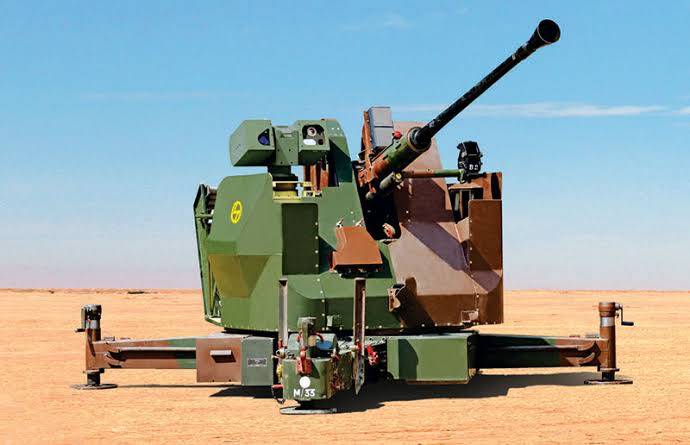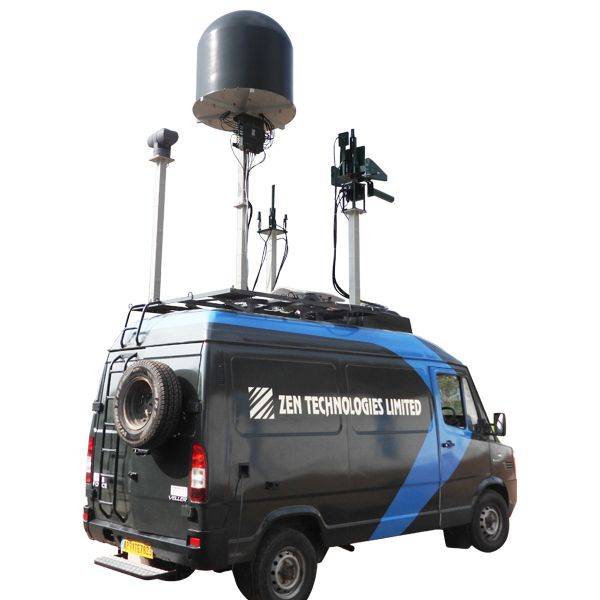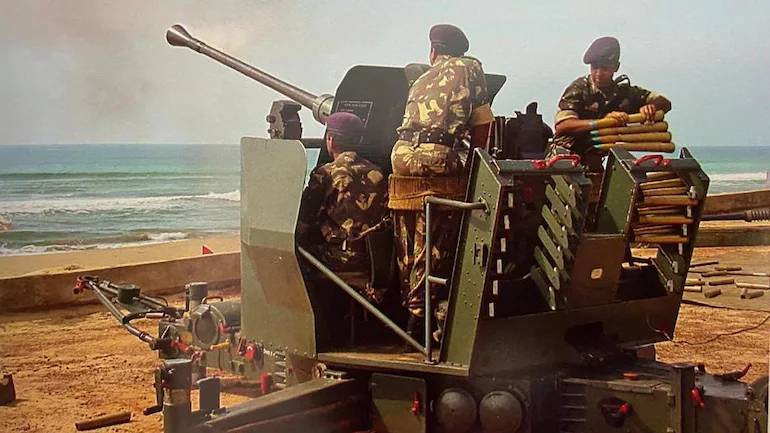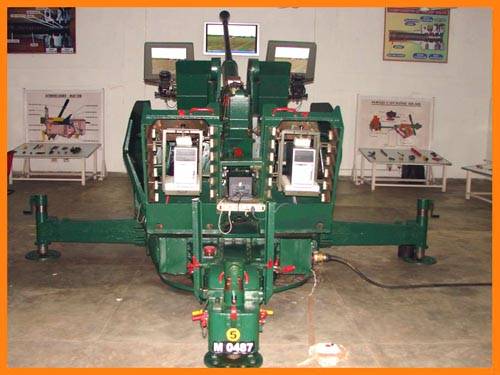An old weapon against new drones. Bofors L70 upgrade option developed in India

In recent years, India has been able to learn from experience how dangerous small lightweight unmanned aerial vehicles can be and how difficult they are to deal with. In this regard, the forces of different organizations are now developing different versions of complexes to repel such a threat. The modernized anti-aircraft gun Bofors L70, the new capabilities of which are provided by a set of modern devices, becomes the next model in this series.
New designs
One of the most active developers of anti-UAV systems in India is Zen Technologies Limited (Hyderabad). Previously, she created, presented and conducted through a full cycle of tests a specialized mobile complex of electronic reconnaissance and combat Zen Anti Drone System (ZADS). In August, the Indian Ministry of Defense issued the company the first order for the serial production of an unnamed number of such complexes.
Last year, Zen Technologies began work on means of destroying air targets. With the assistance of other organizations and companies, she developed a project to modernize the old Bofors L70 anti-aircraft gun with a 40-mm automatic gun. Due to a set of modern devices, an increase in the accuracy of shooting at small targets is ensured, and the effectiveness of destruction is increased with the help of a new ammunition.
The first test and demo shooting using the new version of the L70 took place on September 17 at one of the Indian training grounds. A few days later, the following test firing took place. In both events, combat crews of anti-aircraft artillery were involved, having undergone the necessary training. Representatives of the command followed the course of the shooting.
As reported, the tracking of the air situation and the detection of a small-sized target was carried out by the calculation of the ZADS complex. The latter identified the UAV control channel, determined the direction to the target and, using an optoelectronic station, specified the coordinates and range to the target. Then the data was transferred to the artillery installation. She quickly aimed her gun and opened fire. Only a few seconds passed from the moment the target was detected until it was hit.

During such tests, the Bofors cannon once again confirmed its characteristics. The new components of the installation also showed their best side. A commercial UAV with a diameter of 600 mm was detected at a great distance and hit from 500 m.
Modernization Methods
In the tests, a prototype is used, rebuilt from the serial L70 installation in a stationary version. It has a cruciform support with jacks, on which a platform with a tool, calculation points and a shield cover of a complex shape rotates. All these units are used practically unchanged.
The installation is based on a 40-mm automatic cannon. It has a 2,8 m long rifled barrel with a flame arrester; the automation uses the energy of the barrel rollback. Unitary shots 40x365 mm R are used in cassettes of 4 pcs. Technical rate of fire - 240 rds / min. The tabular muzzle velocity exceeds 1 km / s. The standard installation provides circular firing in azimuth and elevation angles up to 90 °.
The project from Zen Technologies provides for the use of a new complex of electronic means for fire control and guidance. So, an antenna device appears above the gun barrel, probably a meter for the initial velocity of a projectile or a fuse control device. To the right of the cannon, on the shield cover, there is an armored casing with an optoelectronic station. On the left there is a rod with a standard gunner's sight.
The features of the equipment inside the shield have not yet been disclosed. In the course of previous upgrades, Indian L70s received electronic fire control systems with monitors for displaying information, remote controls and electric aiming drives. Probably, all these devices were saved in the new project, but they were supplemented with new devices.

To improve the firing qualities of the installation, Bharat Dynamics Limited (BDL) has developed a new round based on a high-explosive fragmentation projectile with a proximity fuse. The type of fuse is not specified. Perhaps it is triggered by the command of the OMS of the cannon when it is near the target. The UAV is struck by a cloud of 1000 tungsten elements. Tests have shown that such ammunition is quite capable of hitting small air targets.
Promising complex
The anti-aircraft gun presented for testing is of some interest. Zen Technologies has proposed a fairly simple and cheap, but at the same time effective and convenient way to deal with the current threat in the form of small-sized UAVs. It combines old and affordable components that reduce the cost of the complex, with new units that increase the main characteristics.
The exact tactical and technical characteristics of the upgraded L70 complex remain unknown. At the same time, its speed and ability to hit small-sized targets at a distance of hundreds of meters are shown. The general capabilities of the new shot from BDL have also been confirmed.
It should be noted that the upgraded Bofors installation is not used independently, but in conjunction with the ZADS system. It is this radio equipment that provides the detection of subtle targets and gives target designation to the gun. Tests have shown that such a complex is quite capable of solving the assigned tasks, at least in the gentle conditions of the landfill.
If adopted, the serial L70s should be reduced to batteries under the control of one command post with electronic reconnaissance equipment. Such a unit will be able to detect and hit different UAVs at a sufficient distance, showing the minimum reaction time. At the same time, the speed of the complex makes it possible to count on the reflection of even massive raids.
It should be noted that the proposed modernization is useful not only from the point of view of combating UAVs. With the correct organization of combat work, the updated L70 will be able to more effectively fight helicopters, low-flying aircraft and even ground targets. The ability to solve such problems will be determined by the characteristics and composition of the air defense control loops.

Apparently, in the near future, the Indian Ministry of Defense and Zen Technologies will conduct new tests, the results of which will decide the fate of the new project. If the anti-UAV complex continues to show the same characteristics as in the first tests, then an order for acceptance into service and the launch of mass production should be expected.
Threat and protection
India is already well aware of the threat in the form of light small-sized UAVs. Such a technique was to the taste of smugglers from the eastern states, and with its help, illegal cargo traffic is carried out across the border. In addition, small Drones have already been used as carriers of warheads to attack military targets.
The Indian military is well aware of how important the means to protect against UAVs are. Several radio systems for this purpose have been developed, and some have even been put into service. Now they pay attention to means of destruction, and the course is immediately taken to integrate new samples for various purposes with obtaining beneficial results.
A promising project from Zen Technologies opens up new opportunities for the Indian army. In service with the ground forces, according to various sources, there are at least 1200 Bofors L70 installations in towed and stationary versions. OK. 200 have been modernized in recent years with the installation of control electronics and electric drives.
These products can be carried through the next stage of updating - and get modern air defense systems of the near zone with wide capabilities. However, it is unlikely that all the existing L70s will be upgraded. This will be prevented by the considerable cost of such a program, and besides, all installations are of considerable age, and many of them are inappropriate to update in any way.
However, even the appearance of a limited number of modernized Bofors L70 can significantly change the state and potential of the air defense of the ground forces and improve the protection of at least certain areas. In addition, a project from Zen Technologies and Bharat Dynamics has already solved one important problem. He showed the fundamental possibility of restructuring an outdated sample into a modern complex capable of hitting complex targets. Perhaps this approach will find application again in the future and will also affect the development of the Indian army.
Information